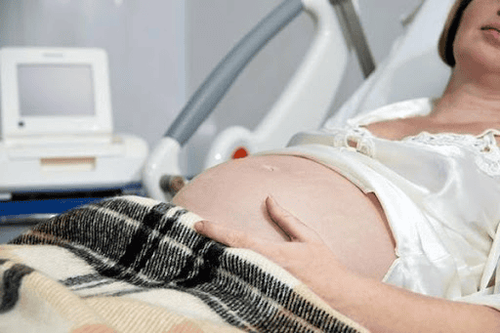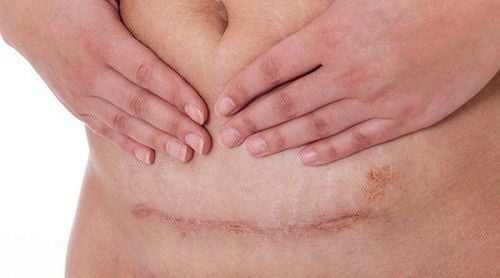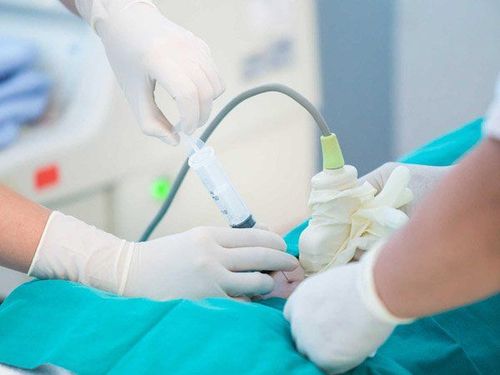This is an automatically translated article.
The article was professionally consulted with Master, Doctor Trinh Thi Thanh Huyen - Obstetrician and Gynecologist - Department of Obstetrics and Gynecology - Vinmec Hai Phong International General Hospital.Chorionic villus sampling is a prenatal test for fetal malformations in which a sample of chorionic villus is removed from the placenta for testing. The sample can be taken through the cervix or the abdominal wall. The results of a chorionic villus sampling can indicate whether your baby has inherited chromosomal diseases, but it is important for the mother and family to understand the possible risks and to be prepared for them. for possible outcomes.
1. What is chorionic villus sampling?
The placenta is a structure in the uterus that supplies blood and nutrients from mother to fetus. Chorionic villi are structural units of placental tissue, look like fingers and contain fetal-like genetic material.Chorionic villus sampling, or chorionic villus biopsy, is a prenatal screening test for fetal malformations that involves taking a tissue sample from the placenta to check for chromosomal abnormalities and a several other genetic problems. This test may be done for suspected genetic defects and disorders, depending on family history and pre-existing risk factors.
Chorionic villus sampling is usually done between the 10th and 12th weeks of pregnancy. Unlike amniocentesis, which is also a type of prenatal test, chorionic villus sampling does not provide information about neural tube defects, such as spina bifida. For this reason, women who undergo chorionic villus sampling should also continue to have follow-up blood tests between 16 and 18 weeks of pregnancy to screen for neural tube defects.
There are two types of chorionic villus sampling procedures:
Transcervical : A catheter is inserted through the cervix into the placenta to collect a tissue sample. Transabdominal wall: A needle is inserted through the abdomen and uterus into the placenta to obtain a tissue sample.

Lấy mẫu nhung mao màng đệm là một xét nghiệm sàng lọc dị tật thai nhi
2. What is the purpose of chorionic villus sampling?
Chorionic villus sampling can provide information about the genomic makeup of the fetus in the uterus. In general, the purpose of chorionic villus sampling is established when the results of this test can have a significant impact on the management of a pregnancy or the desire to continue the pregnancy.Women will be considered for chorionic villus sampling if:
There have been positive results from prenatal screening tests. If the results of a screening test - such as first trimester screening or prenatal cell-free DNA screening - are positive or suspect, you may continue to have velvet sampling. choroidal capillaries to confirm or rule out the diagnosis. Had an abnormal chromosomal condition in a previous pregnancy. If a previous pregnancy had Down syndrome or any other chromosomal disorder, this pregnancy may also have a higher risk than the general population. From 35 years old and up. Babies born to women 35 years of age or older have a higher risk of chromosomal conditions, such as Down syndrome. There is a family history of a specific genetic condition, such as a parent, sibling or husband of the woman who is a known carrier of the genetic condition. For the diagnosis of many other genetic conditions - including single gene disorders such as Tay-Sachs and cystic fibrosis. However, your doctor will be wary of taking a transcervical chorionic villus sampling - done through the vagina - if you have:
Active vaginal or cervical infection Vaginal bleeding in the previous two weeks Placenta inaccessible Similarly, performing transabdominal chorionic villus sampling will also be more difficult if the uterus is tilted posteriorly or the placenta is in the posterior wall of the uterus.
3. How is the chorionic villus sampling procedure performed?
3.1 Preparation of tricks
Your doctor will explain the chorionic villus sampling procedure to you and your family, and explain all the questions you may have about the procedure. Upon consent, the mother or her representative will be asked to sign a consent form authorizing the procedure.In general, there were no special dietary or activity requirements prior to chorionic villus sampling. If you have a history of allergies or are being treated with medications, both prescription and over-the-counter, and herbal supplements, you should tell your doctor.
In addition, you also need to let your doctor know if you have a history of bleeding disorders or if you are taking any anticoagulant drugs, such as aspirin or any other drug that may affect the process. coagulation. Because this is an invasive procedure, you may need to stop taking these medications before the procedure.
At the same time, it is necessary to let the doctor know if the mother is Rh negative. During chorionic villus sampling, blood cells from the mother and fetus can be mixed. This can lead to Rh sensitization and breakdown of the baby's red blood cells. Therefore, Rh factor testing is mandatory before performing chorionic villus sampling as well as routine testing during pregnancy.
The woman is instructed to urinate or to hold her urine immediately before the procedure. Depending on the position of the uterus and placenta, an empty or full bladder can help move the uterus into a better position for the procedure.
3.2 Performing the trick
Chorionic villus sampling can be done in an outpatient setting or as part of a hospital stay.This procedure includes the following steps:
Change from the waist down and put on a hospital gown Lie on the procedure table and put your hands behind your head Vital signs, including blood pressure, heart rate and breathing will be checked An ultrasound will be done to check the fetal heart rate and the position of the placenta, fetus, and umbilical cord Based on the position of the placenta, chorionic villus sampling is performed will be decided whether to perform transcervical or transabdominal For transcervical chorionic villus sampling:
The doctor will insert an instrument called a speculum into the woman's vagina to expose the cervix The vagina and cervix will be cleaned with an antiseptic solution. Under ultrasound guidance, a thin tube will be guided through the cervix to the choroidal villi A small number of cells will is gently aspirated through the tube into a syringe Finally the tube will be withdrawn For transabdominal chorionic villus sampling:
The site of the procedure on the abdominal wall will be cleaned with an antiseptic and injected with a local anesthetic An ultrasound will be used to help guide a long, thin, hollow needle through the abdominal wall and into the uterus and placenta A small number of cells will The needle is gently aspirated through the needle lumen. The needle is then withdrawn and an adhesive bandage is applied to the puncture site. At the completion of both methods, the maternal and fetal status will be re-evaluated. The chorionic villus tissue sample will be properly preserved and promptly sent to the laboratory. If you are Rh negative, you may be given an injection of Rh (D) immune globulin. This is a specially formulated blood product that can prevent Rh negative maternal antibodies from reacting with Rh positive fetal cells.
3.3 End of the trick
You may experience mild pain and cramping for a few hours afterward.It is recommended to rest at home and avoid strenuous activities for at least 24 hours.
Do not douche or have sex for 2 weeks after or until directed by your doctor.
Watch and tell your doctor about any of the following:
Bleeding or leaking of amniotic fluid from the puncture site on the abdominal wall or vagina Fever or chills Severe abdominal pain or cramps risk when performing chorionic villus sampling
Chorionic villus sampling is one of the factors that can increase the risk of miscarriage, with a ratio of 1 in 100. However, it cannot be ruled out that the cause of this event is a genetic abnormality that the fetus has acquired.
In addition, the risk of miscarriage depends on the experience of the surgeon performing the procedure, the anatomical abnormalities of the uterine position, the position of the placenta, and the difficulty of sampling. Therefore, it is important that the chorionic villus sampling test should only be performed by a physician experienced in this technique and performed after the 11th week of pregnancy.

Sản phụ và gia đình cần được giải thích rõ ràng về quy trình lấy mẫu nhung mao màng đệm
4. How to evaluate the results of chorionic villus sampling?
After conducting chorionic villus sampling, the patient will be taken to the laboratory to be examined under the microscope. The number of chromosomes in the cell will be counted and the structure of the chromosomes will be checked for any abnormalities. The results of chorionic villus sampling are estimated to be accurate in about 99 cases out of 100.However, this test is absolutely not able to check for every birth defect and may not give accurate results. In about 1 in every 100 cases, the results cannot be completely certain that the fetal chromosomes are normal. If this happens, you may need additional screening tests, such as testing for chromosomes in cells from both parents or amniocentesis to further confirm the diagnosis.
The results will be available within a few days and will let you know if a major chromosomal abnormality has been detected. The analysis can take 2 to 3 weeks to a month for full results, including for smaller, rarer chromosomal abnormalities.
Sometimes it is possible to have a normal chorionic villus sampling but then the baby is born with another genetic abnormality. This is because normal test results cannot rule out every possible genetic disorder. Therefore, before starting chorionic villus sampling, the mother and her family need to consider future options against all possible outcomes, including:
Continue carrying pregnancy, and gather more information about the condition through other tests to prepare for the care of the newborn as soon as it is born Termination of the pregnancy and selection of the appropriate method In summary, sampling chorionic villus is a prenatal test that takes a sample of some placental tissue to check for chromosomal abnormalities and certain other genetic problems. However, it is important for the mother and family to be clearly explained about the chorionic villus sampling procedure, possible risks, and how to respond to each result in order to effectively perform this procedure. maximum gain.
Vinmec International General Hospital is one of the hospitals that not only ensures professional quality with a team of leading medical doctors, a system of modern equipment and technology. The hospital provides comprehensive and professional medical examination, consultation and treatment services, with a civilized, polite, safe and sterile medical examination and treatment space.
Please dial HOTLINE for more information or register for an appointment HERE. Download MyVinmec app to make appointments faster and to manage your bookings easily.
Article references: mayoclinic.org, hopkinsmedicine.org, nhs.uk, pregnancybirthbaby.org.au












